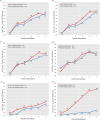Genetic characterization and molecular epidemiological analysis of novel enterovirus EV-B80 in China
- PMID: 30482903
- PMCID: PMC6258725
- DOI: 10.1038/s41426-018-0196-9
Genetic characterization and molecular epidemiological analysis of novel enterovirus EV-B80 in China
Abstract
Enterovirus B80 (EV-B80) is a newly identified serotype belonging to the enterovirus B species. To date, only two full-length genomic sequences of EV-B80 are available in GenBank, and few studies on EV-B80 have been conducted in China or worldwide. More information and research on EV-B80 is needed to assess its genetic characteristics, phylogenetic relationships, and association with enteroviral diseases. In this study, we report the phylogenetic characteristics of three Xinjiang EV-B80 strains and one Tibet EV-B80 strain in China. The full-length genomic sequences of four strains show 78.8-79% nucleotide identity and 94-94.2% amino acid identity with the prototype of EV-B80, indicating a tendency for evolution. Based on a maximum likelihood phylogenetic tree based on the entire VP1 region, three genotypes (A-C) were defined, revealing the possible origin of EV-B80 strains in the mainland of China. Recombination analysis revealed intraspecies recombinations in all four EV-B80 strains in nonstructural regions along with two recombination patterns. Due to the geographic factor, the coevolution of EV-B strains formed two different patterns of circulation. An antibody seroprevalence study against EV-B80 in two Xinjiang prefectures also showed that EV-B80 strains were widely prevalent in Xinjiang, China, compared to other studies on EV-B106 and EV-B89. All four EV-B80 strains are not temperature sensitive, showing a higher transmissibility in the population. In summary, this study reports the full-length genomic sequences of EV-B80 and provides valuable information on global EV-B80 molecular epidemiology.
Conflict of interest statement
The authors declare that they have no conflict of interest.
Figures





Similar articles
-
Phylogenetic Characterizations of Highly Mutated EV-B106 Recombinants Showing Extensive Genetic Exchanges with Other EV-B in Xinjiang, China.Sci Rep. 2017 Feb 23;7:43080. doi: 10.1038/srep43080. Sci Rep. 2017. PMID: 28230168 Free PMC article.
-
Phylogenetic characteristics and molecular epidemiological analysis of novel enterovirus EV-B83 isolated from Tibet, China.Sci Rep. 2020 Apr 20;10(1):6630. doi: 10.1038/s41598-020-63691-4. Sci Rep. 2020. PMID: 32313119 Free PMC article.
-
Antigenic characteristics and genomic analysis of novel EV-A90 enteroviruses isolated in Xinjiang, China.Sci Rep. 2018 Jul 6;8(1):10247. doi: 10.1038/s41598-018-28469-9. Sci Rep. 2018. PMID: 29980696 Free PMC article.
-
Circulation of two Enterovirus C105 (EV-C105) lineages in Europe and Africa.J Gen Virol. 2015 Jun;96(Pt 6):1374-1379. doi: 10.1099/vir.0.000088. Epub 2015 Feb 9. J Gen Virol. 2015. PMID: 25667329 Review.
-
Epidemiology of Enterovirus Genotypes in Association with Human Diseases.Viruses. 2024 Jul 19;16(7):1165. doi: 10.3390/v16071165. Viruses. 2024. PMID: 39066327 Free PMC article. Review.
Cited by
-
Molecular Epidemiology and Evolution of Coxsackievirus A14.Viruses. 2023 Nov 26;15(12):2323. doi: 10.3390/v15122323. Viruses. 2023. PMID: 38140564 Free PMC article.
-
Tracking echovirus eleven outbreaks in Guangdong, China: a metatranscriptomic, phylogenetic, and epidemiological study.Virus Evol. 2020 May 10;6(1):veaa029. doi: 10.1093/ve/veaa029. eCollection 2020 Jan. Virus Evol. 2020. PMID: 32411392 Free PMC article.
-
Genomic characteristics of human respiratory syncytial virus from children in China during 2017-2020.Arch Virol. 2024 Oct 10;169(11):219. doi: 10.1007/s00705-024-06138-9. Arch Virol. 2024. PMID: 39387930
-
A Large-Scale Outbreak of Echovirus 30 in Gansu Province of China in 2015 and Its Phylodynamic Characterization.Front Microbiol. 2020 Jun 10;11:1137. doi: 10.3389/fmicb.2020.01137. eCollection 2020. Front Microbiol. 2020. PMID: 32587581 Free PMC article.
-
Molecular Identification of Enteric Viruses in Domestic Animals in Northeastern Gabon, Central Africa.Animals (Basel). 2023 Aug 3;13(15):2512. doi: 10.3390/ani13152512. Animals (Basel). 2023. PMID: 37570320 Free PMC article.
References
-
- Zell R., Delwart E., Gorbalenya A. E., Hovi T., King A. M. Q., Knowles N. J., Lindberg A. M., Pallansch M. A., Palmenberg A. C., Reuter G., Simmonds P., Skern T., Stanway G., Yamashita T. ICTV Virus Taxonomy Profile: Picornaviridae. Journal of General Virology. 2017;98(10):2421–2422. doi: 10.1099/jgv.0.000911. - DOI - PMC - PubMed
-
- Muslin C, Joffret ML, Pelletier I, Blondel B, Delpeyroux F. Evolution and emergence of enteroviruses through intra and inter-species recombination: plasticity and phenotypic impact of modular genetic exchanges in the 5′ untranslated region. PLoS Pathog. 2015;11:e1005266. doi: 10.1371/journal.ppat.1005266. - DOI - PMC - PubMed
MeSH terms
Substances
Grants and funding
LinkOut - more resources
Full Text Sources
Other Literature Sources
